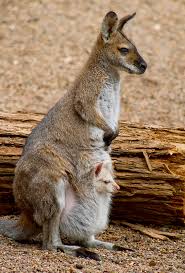12
Aug
Atrazine Found to Harm Marsupial Health
 (Beyond Pesticides, August 12, 2020) The herbicide atrazine can interfere with the health and reproduction of marsupials (including kangaroos and opossums) kangaroo, Virginia opossum, according to research published in the journal Reproduction, Fertility, and Development. Although the research focuses on the health of the Australian wallaby, the data is relevant for the only marsupial in the United States, the opossum. Unfortunately, the research is no surprise, as atrazine has a long history of displaying endocrine (hormone) disrupting properties, affecting sex and reproduction in a broad range of species.
(Beyond Pesticides, August 12, 2020) The herbicide atrazine can interfere with the health and reproduction of marsupials (including kangaroos and opossums) kangaroo, Virginia opossum, according to research published in the journal Reproduction, Fertility, and Development. Although the research focuses on the health of the Australian wallaby, the data is relevant for the only marsupial in the United States, the opossum. Unfortunately, the research is no surprise, as atrazine has a long history of displaying endocrine (hormone) disrupting properties, affecting sex and reproduction in a broad range of species.
The study, under the auspices of University of Melbourne Animal Experimentation and Ethics Committee, exposed pregnant female adult wallabies to atrazine through gestation, birth, and lactation. Doses of the weedkiller were slightly higher than real world models, but according to researchers, “It is quite possible a wild animal could get such an exposure.” Researchers then euthanized the newborn wallabies to study atrazine’s effects.
The gonads and phallus of young wallabies were analyzed for any physiological changes or impacts to gene expression. Researchers found changes to the gene expression necessary for basic function of the testis, and a significant reduction in phallus length. “These results demonstrate that [atrazine] exposure during gestation and lactation can significantly affect the development of male young by affecting virilization,” the authors write.
“With the marsupial’s unique mode of reproduction and the young completing their development in the pouch, mothers are unknowingly passing the toxins on in their breast milk, exposing their young to environmental toxins,” said Andrew Pask, PhD, an expert in genetics at University of Melbourne. “Exposures to atrazine is causing major abnormalities in the male reproductive system in many animals, triggering male sterility or even male-to-female sex reversal in frogs.”
Indeed, Tyrone Hayes, PhD, at the University of California, Berkeley, first uncovered atrazine’s potent ability to harm reproductive health through seminal work on amphibian development. Dr. Hayes found that exposure to atrazine at doses as low as 0.1 parts per billion (well below regulatory limits in the US and Australia) had the ability to turn tadpoles into hermaphrodites.
His research, covered at length in a New Yorker article published in 2014, has been the subject of incessant attacks by the major worldwide manufacturer of atrazine, Syngenta (now owned by ChemChina). But as Dr. Hayes notes in his lectures, over and over again, in research across the globe, studies in frogs as well as other animals – from fish to humans, have confirmed atrazine’s ability to affect proper hormonal functioning and impact reproduction.
In Australia, one in five native mammals are at threat of extinction. Animals in North America are not fairing much better, as the continent is in the midst of a wildlife crisis. A study published late last year found that 3 billion North American birds have been killed off since the 1970s. While problems with marsupials may not seem relevant to readers in the United States, it is important to note that opossums, the only North American marsupial, plays a key pest management role in many ecosystems. The opossum is the a voracious eater of ticks, with a single animal able to hoover upwards of 5,000 ticks in a single season.
As it stands, the U.S. Environmental Protection Agency (EPA) is permitting atrazine herbicides to be applied to farmland throughout the country without any meaningful oversight. Earlier this year the Trump Administration announced that it would waive a requirement that Syngenta-ChemChina monitor waterways in the Midwest for atrazine contamination. Rather than use the coronavirus crisis to increase environmental monitoring in order to avoid exposure to pesticides that weaken the immune system, the Trump Administration is working in coordination with chemical companies to use the Covid crisis to reduce health and environmental protections.
Worse yet, EPA is set to reregister atrazine for another 15 years of hazardous use. Take action by telling EPA to ban atrazine and other pesticides in the triazine class. For more information on the dangers pesticides pose to animal health, see Beyond Pesticides’ wildlife program page.
Source: Science Daily press release, Reproduction, Fertility, and Development.
All unattributed positions and opinions in this piece are those of Beyond Pesticides.










